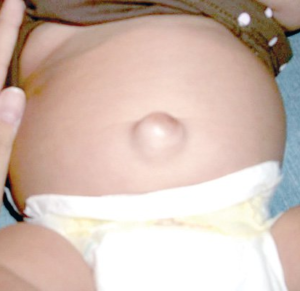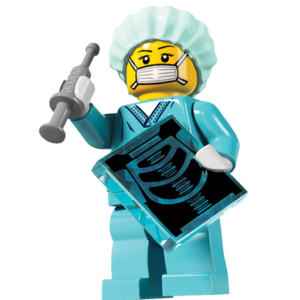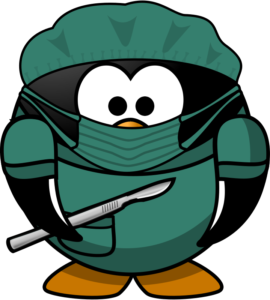What is an Umbilical Hernia
An Umbilical Hernia occurs when some of the contents of the tummy (fat or bowel) pokes out through the tummy wall at the belly button (umbilicus). It is a common thing to find in babies and young children. Around 1 in 5 babies have an umbilical hernia in the first few months of life. Umbilical Hernias occur more frequently in the African population.
Why do they occur?
The umbilical cord contains the blood vessels that connect the mum to baby during development. This is how the baby gets all of the oxygen and nutrients that it needs from mum. The site where the umbilical cord connects to the baby will become the belly button. The blood vessels pass through the tummy wall. To allow this to happen there is a small gap (or defect) in the tummy wall.
After birth the umbilical cord will fall off. The defect in the tummy wall is still there after the umbilical cord has fallen off. Normally this defect gets smaller as the child grows and eventually closes. This can take a few years. If the contents of the tummy (fat or bowel) poke out through this defect then the child has an umbilical hernia.
Normally with time the umbilical hernia will disappear by itself without any treatment as the opening in the tummy wall closes by itself.
There are some things that make umbilical hernias more likely
- Prematurity
- Low birth weight
- Some syndromes where umbilical hernias are seen more commonly (Down’s syndrome, Beckwith-Wiedeman syndrome, Ehler-Danlos syndrome
How do I know if my child has an umbilical hernia?
An Umbilical hernia shows as a swelling at the belly button.
The swelling can change in size. It often gets bigger if the child is crying or straining to go to the toilet.
If you feel the swelling when the child is relaxed, it feels soft. Some people have described it as ‘squidgy’. An experienced doctor can often get the swelling to disappear.
Umbilical hernias do not normally cause pain. Some children will ‘play’ with their hernia.
Unlike in adults where hernias around the belly button can cause problems, umbilical hernias do not normally cause any complications in children. Very rarely a hernia can become stuck (incarcerated). This can cause pain and the swelling becomes red and tender to touch. If this happens then it is important to get your child seen by a doctor as soon as possible.

What is the treatment of an Umbilical Hernia?
In general if a young child has an Umbilical Hernia, it will disappear on its own and does not need treatment.
If the hernia is still present when a child reaches the age of 4, then treatment may be recommended. Treatment may be considered earlier in specific circumstances - eg Hernias that have a large defect and are unlikely to disappear on their own or hernias that have been stuck out (incarcerated).
The treatment for an umbilical hernia is an operation called an Umbilical Hernia Repair.
Information about Umbilical Hernia Repair
The operation to repair an Umbilical Hernia is an Umbilical Hernia Repair.
Click the button below to find out more information about this procedure.
Useful Links
For Health Care Professionals
- Management of Paediatric Hernias. Bowling K, Hart N et al. BMJ 2017;359:j4484
This is a useful general overview looking at common paediatric hernias (Umbilical, Inguinal and epigastric)
For Parents and Carers
The information provided in this information leaflet id meant to provide general information only. It does not replace a consultation with a doctor who will be able to give you information tailored to the patient.

